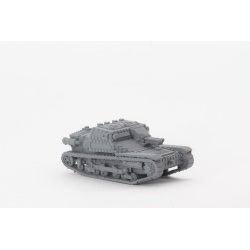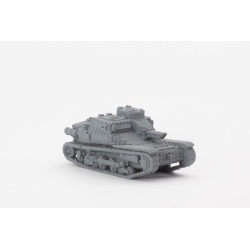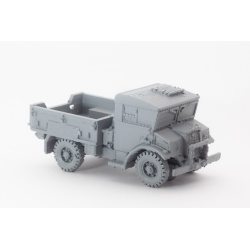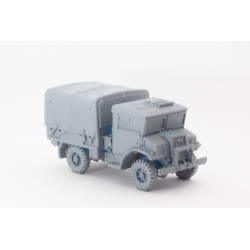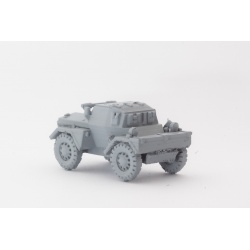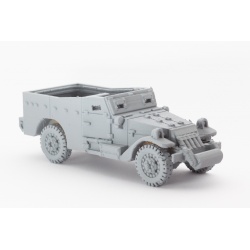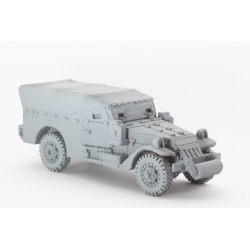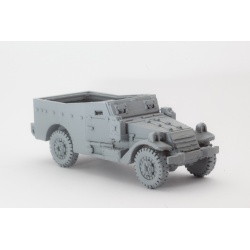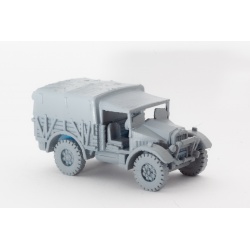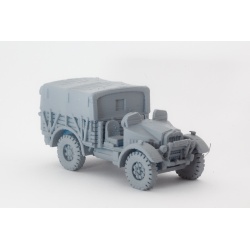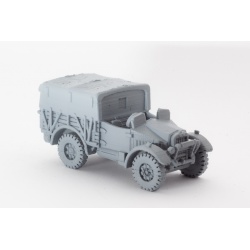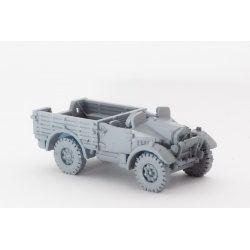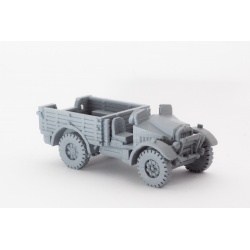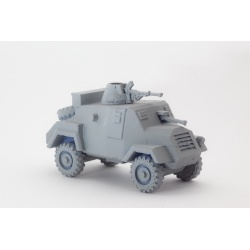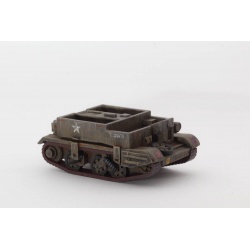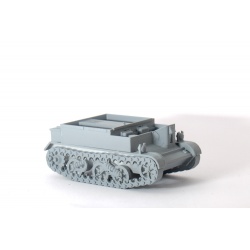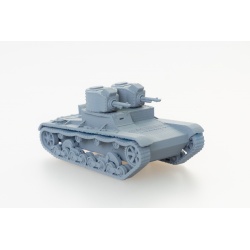Greece
Carro Veloce CV-35M
Model comes as one part.
Also known as the L3/35, this was a turretless tankette produced by Fiat and Ansaldo in Italy. It was based on the Carden Lloyd tankette.
It as the most numerous Italian fighting vehicle and saw action throughout the war wherever Italy fought.
Some 2,700 models were produced and there were several variants. The series I had a single machine gun, this was uprated to twin machine guns for the series II
This version is armed with 2 8mm machine guns. The main difference between the 33 and 35 was that the 35 had bolted armour rather than riveted and the twin machine guns were standard
Also known as the L3/35, this was a turretless tankette produced by Fiat and Ansaldo in Italy. It was based on the Carden Lloyd tankette.
It as the most numerous Italian fighting vehicle and saw action throughout the war wherever Italy fought.
Some 2,700 models were produced and there were several variants. The series I had a single machine gun, this was uprated to twin machine guns for the series II
This version is armed with 2 8mm machine guns. The main difference between the 33 and 35 was that the 35 had bolted armour rather than riveted and the twin machine guns were standard
Italian Tankette
Carro Veloce CV-35M Command
Model comes as one part.
Also known as the L3/35, this was a turretless tankette produced by Fiat and Ansaldo in Italy. It was based on the Carden Lloyd tankette.
It as the most numerous Italian fighting vehicle and saw action throughout the war wherever Italy fought.
Some 2,700 models were produced and there were several variants. The series I had a single machine gun, this was uprated to twin machine guns for the series II
This version is armed with 2 8mm machine guns. The main difference between the 33 and 35 was that the 35 had bolted armour rather than riveted and the twin machine guns were standard.
The command version has the extra battery boxes either side of the engine block for radios.
Also known as the L3/35, this was a turretless tankette produced by Fiat and Ansaldo in Italy. It was based on the Carden Lloyd tankette.
It as the most numerous Italian fighting vehicle and saw action throughout the war wherever Italy fought.
Some 2,700 models were produced and there were several variants. The series I had a single machine gun, this was uprated to twin machine guns for the series II
This version is armed with 2 8mm machine guns. The main difference between the 33 and 35 was that the 35 had bolted armour rather than riveted and the twin machine guns were standard.
The command version has the extra battery boxes either side of the engine block for radios.
Italian Tankette
CMP C15A 15cwt Truck
Model comes as one part.
The C15A was a Canadian designed and built truck to British Army requirements for use in the armies of the Commonwealth.
It came in many versions and some 500,000 were built between 1940 and 1945.
This is the 4x4 15cwt version without a cover.
The C15A was a Canadian designed and built truck to British Army requirements for use in the armies of the Commonwealth.
It came in many versions and some 500,000 were built between 1940 and 1945.
This is the 4x4 15cwt version without a cover.
Canadian Military Pattern Truck
CMP C15A 15cwt Truck (covered)
Model comes as one part.
The C15A was a Canadian designed and built truck to British Army requirements for use in the armies of the Commonwealth.
It came in many versions and some 500,000 were built between 1940 and 1945.
This is the 4x4 15cwt version with a cover.
The C15A was a Canadian designed and built truck to British Army requirements for use in the armies of the Commonwealth.
It came in many versions and some 500,000 were built between 1940 and 1945.
This is the 4x4 15cwt version with a cover.
Canadian Military Pattern Truck
Daimler Scout Car (closed)
Model comes as one part.
The Daimler Scout Car was also known as the Daimler Dingo.
It was a light, fast 4-wheel-drive reconnaissance vehicle and served with the British Army from 1940 up until 1974.
6,626 were built and it had a crew of two. Main armamanet consisted of a .303 Bren Gun or a .55 Boys Anti Tank Rifle.
MkI, II and III versions were produced.
The Daimler Scout Car was also known as the Daimler Dingo.
It was a light, fast 4-wheel-drive reconnaissance vehicle and served with the British Army from 1940 up until 1974.
6,626 were built and it had a crew of two. Main armamanet consisted of a .303 Bren Gun or a .55 Boys Anti Tank Rifle.
MkI, II and III versions were produced.
Dingo
M3A1 White Scout Car
Model comes as one part.
The White M3 Scout car was designed in 1937 and came about as a result of a request for a fast armoured car capable of towing the standard 37mm artillery piece.
The M3A1 was an improvement from 1940 with a longer hull and an unditching roller.
It was capable of being armed with three machine guns on rails, a 50cal and two 30cals. They served in the Phillipines and North Africa and many were sent to Russia.
They weighed 4 tonnes and carried a driver plus seven.
The White M3 Scout car was designed in 1937 and came about as a result of a request for a fast armoured car capable of towing the standard 37mm artillery piece.
The M3A1 was an improvement from 1940 with a longer hull and an unditching roller.
It was capable of being armed with three machine guns on rails, a 50cal and two 30cals. They served in the Phillipines and North Africa and many were sent to Russia.
They weighed 4 tonnes and carried a driver plus seven.
armoured car
M3A1 White Scout Car (covered)
Model comes as one part.
The White M3 Scout car was designed in 1937 and came about as a result of a request for a fast armoured car capable of towing the standard 37mm artillery piece.
The M3A1 was an improvement from 1940 with a longer hull and an unditching roller.
It was capable of being armed with three machine guns on rails, a 50cal and two 30cals. They served in the Phillipines and North Africa and many were sent to Russia.
They weighed 4 tonnes and carried a driver plus seven.
The White M3 Scout car was designed in 1937 and came about as a result of a request for a fast armoured car capable of towing the standard 37mm artillery piece.
The M3A1 was an improvement from 1940 with a longer hull and an unditching roller.
It was capable of being armed with three machine guns on rails, a 50cal and two 30cals. They served in the Phillipines and North Africa and many were sent to Russia.
They weighed 4 tonnes and carried a driver plus seven.
Armoured Car
M3A1 White Scout Car (no roller)
Model comes as one part.
The White M3 Scout car was designed in 1937 and came about as a result of a request for a fast armoured car capable of towing the standard 37mm artillery piece.
The M3A1 was an improvement from 1940 with a longer hull and an unditching roller.
It was capable of being armed with three machine guns on rails, a 50cal and two 30cals. They served in the Phillipines and North Africa and many were sent to Russia.
They weighed 4 tonnes and carried a driver plus seven.
The White M3 Scout car was designed in 1937 and came about as a result of a request for a fast armoured car capable of towing the standard 37mm artillery piece.
The M3A1 was an improvement from 1940 with a longer hull and an unditching roller.
It was capable of being armed with three machine guns on rails, a 50cal and two 30cals. They served in the Phillipines and North Africa and many were sent to Russia.
They weighed 4 tonnes and carried a driver plus seven.
armoured car
Morris Commercial CS8 (cover, no doors)
Model comes in one part.
The Morris Commercial CS8 was a British truck used during WWII and beyond. It came in three versions, Mk I, II & III.
Until 1940 the vehicle was firtted with small aeroscreens and canvas doors. During 1941 models were fitted with full windscreens and metal skinned half-doors.
Some 21, 300 vehicles were produced between 1934 and 1941.
We have several versions of the CS8 available.
This one has a covered back and cab with no doors.
The Morris Commercial CS8 was a British truck used during WWII and beyond. It came in three versions, Mk I, II & III.
Until 1940 the vehicle was firtted with small aeroscreens and canvas doors. During 1941 models were fitted with full windscreens and metal skinned half-doors.
Some 21, 300 vehicles were produced between 1934 and 1941.
We have several versions of the CS8 available.
This one has a covered back and cab with no doors.
British Truck
Morris Commercial CS8 (cover, no doors, no cab roof)
Model comes in one part.
The Morris Commercial CS8 was a British truck used during WWII and beyond. It came in three versions, Mk I, II & III.
Until 1940 the vehicle was firtted with small aeroscreens and canvas doors. During 1941 models were fitted with full windscreens and metal skinned half-doors.
Some 21, 300 vehicles were produced between 1934 and 1941.
We have several versions of the CS8 available.
This one has a covered back and cab with no doors.
The Morris Commercial CS8 was a British truck used during WWII and beyond. It came in three versions, Mk I, II & III.
Until 1940 the vehicle was firtted with small aeroscreens and canvas doors. During 1941 models were fitted with full windscreens and metal skinned half-doors.
Some 21, 300 vehicles were produced between 1934 and 1941.
We have several versions of the CS8 available.
This one has a covered back and cab with no doors.
British Truck
Morris Commercial CS8 (covered, no cab)
Model comes in one part.
The Morris Commercial CS8 was a British truck used during WWII and beyond. It came in three versions, Mk I, II & III.
Until 1940 the vehicle was fitted with small aeroscreens and canvas doors. During 1941 models were fitted with full windscreens and metal skinned half-doors.
Some 21, 300 vehicles were produced between 1934 and 1941.
We have several versions of the CS8 available.
This one has an covered back, open cab with doors.
The Morris Commercial CS8 was a British truck used during WWII and beyond. It came in three versions, Mk I, II & III.
Until 1940 the vehicle was fitted with small aeroscreens and canvas doors. During 1941 models were fitted with full windscreens and metal skinned half-doors.
Some 21, 300 vehicles were produced between 1934 and 1941.
We have several versions of the CS8 available.
This one has an covered back, open cab with doors.
British Truck
Morris Commercial CS8 (cut down)
Model comes in one part.
The Morris Commercial CS8 was a British truck used during WWII and beyond. It came in three versions, Mk I, II & III.
Until 1940 the vehicle was firtted with small aeroscreens and canvas doors. During 1941 models were fitted with full windscreens and metal skinned half-doors.
Some 21, 300 vehicles were produced between 1934 and 1941.
We have several versions of the CS8 available.
This one has an open back and doors.
The Morris Commercial CS8 was a British truck used during WWII and beyond. It came in three versions, Mk I, II & III.
Until 1940 the vehicle was firtted with small aeroscreens and canvas doors. During 1941 models were fitted with full windscreens and metal skinned half-doors.
Some 21, 300 vehicles were produced between 1934 and 1941.
We have several versions of the CS8 available.
This one has an open back and doors.
British Truck
Morris Commercial CS8 (open back, no doors)
Model comes in one part.
The Morris Commercial CS8 was a British truck used during WWII and beyond. It came in three versions, Mk I, II & III.
Until 1940 the vehicle was firtted with small aeroscreens and canvas doors. During 1941 models were fitted with full windscreens and metal skinned half-doors.
Some 21, 300 vehicles were produced between 1934 and 1941.
We have several versions of the CS8 available.
This one has an open back and no doors.
The Morris Commercial CS8 was a British truck used during WWII and beyond. It came in three versions, Mk I, II & III.
Until 1940 the vehicle was firtted with small aeroscreens and canvas doors. During 1941 models were fitted with full windscreens and metal skinned half-doors.
Some 21, 300 vehicles were produced between 1934 and 1941.
We have several versions of the CS8 available.
This one has an open back and no doors.
British Truick
Otter Light Reconnaissance Vehicle
Model comes in 11 parts.
The Otter was alight armoured car produced by Canada for the British and Commonwealth forces.
It was armed with a hull mounted Boyes .55 anti tank rifle and a turret mounted bren gun.
The Otter was alight armoured car produced by Canada for the British and Commonwealth forces.
It was armed with a hull mounted Boyes .55 anti tank rifle and a turret mounted bren gun.
Light Reconnaissance Car
Universal Carrier (v.2 no skirts)
Model comes as four parts.
The Universal Carrier was also known as a Bren Carrier or Bren Gun Carrier and came in many variations.
They served in WWII and several subsequent conflicts including the 1948 Arab-Israeli War, Korea and Indochina.
This is one version of several Bren carriers we produce.
The Universal Carrier was also known as a Bren Carrier or Bren Gun Carrier and came in many variations.
They served in WWII and several subsequent conflicts including the 1948 Arab-Israeli War, Korea and Indochina.
This is one version of several Bren carriers we produce.
Bren Gun Carrier
Vickers Mark E - version A
This model comes as four parts; hull, turret & tracks.
The Mark E was first built in 1928. It came in A & B versions. The A version had two turrets with a machine gun each.
The Mark E weighed some 7.3 tonnes, had a top speed of 22 mph and had a crew of three.
The Mark E was first built in 1928. It came in A & B versions. The A version had two turrets with a machine gun each.
The Mark E weighed some 7.3 tonnes, had a top speed of 22 mph and had a crew of three.
British WWI Tank
- 1


